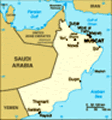Advertisement
Published: October 27th 2023
On the way back from Jebel Akhdar to Dubai, we visited the old ruined village of Al Hamra. It was a bit off the main road and the directions took us via very narrow streets through date palm farms. It was a beautiful drive. We arrived on the other side of the museum from our colleagues, so did not know they were there already. So, the four of us toured the ruined village of Al Hamra for a few minutes, before meeting everyone at the Bait Safah Museum. One of the cool things we saw was a public bath-house, a little alcove along the street sitting above the falaj where people can wash themselves in water destined for the farms.
Al Hamra is a 400-year-old village near Nizwa and Jebel Shams areas. It has some of the oldest preserved homes in Oman as well as many ruins. Most of the homes here were 2 or 3 stories high, made of mud and stone, with date palm fronds and trunks making up the ceilings and beams. My friend said it reminded her of the mud villages in Yemen. It really was beautiful and a shame that it was not fully functioning.
Many of the walls in the old village area had crumbled down, but it had its own beauty juxtaposed against the green palm trees, the yellow walls, the reddish mountains and the blue sky.
Bait al Safah Museum is housed within an old building that served as a main house of the village chief; it was 3 stories high with the public and fundamental rooms (such as date presses, animal alcoves, kitchen) on the ground floor, the main housing quarters on the middle floor and the additional space on the top floor. The sons would remain in their family homes, while wives were brought from their homes to live; once the sons were married and had their own family, they got a room on the main floor. The upper floor slept the single kids. But from the top room was access to the expansive roof with amazing views over the village, farms and mountains. Breathtaking really.
In the museum, we were given a tour and shown how people used to live during this period. I swear, I am continually amazed at the amount of uses they were able to get out of the date palms. Aside from construction
materials, they took the dates and pressed for juice and for syrup (delicious!). The syrup was good for about 18 months; once it was too old to consume, they would paint the walls with it and set it on fire to help waterproof it. Genius! I bought a few small bottles of the date syrup. Then we went to another room where two older women demonstrated how to make Omani bread (simple: flour, water, and salt). They also showed us green Yemeni coffee beans (many from this area are culturally Yemeni), saffron paste they put on our heads to help alleviate headaches, bracelets, herbs, oils.... Lots of stuff. Upstairs we toured the living quarters, which had some historical artefacts, before sitting down and enjoying a cup of coffee. Our museum guide told us what a lot of the coffee gestures mean: put in front of you means you would like more, shaking means you're finished, put on the ground means you want to speak. He said that in Bahrain, the host will fill your cup to the brim when it is time for you to leave! Ha!
After this, we went down to the "classic car" tour. I thought
it was actual classic cars, but they are extended golf carts which are designed to look like classic cars. Still pretty cool. They drove us through the village, past the old souq, and into the agricultural areas. Besides the many date palm farms, there are large fields of herbs and vegetables that they use or use as feed for the animals (such as corn). Then we were taken to the main falaj area for the town. Here it diverts into a fork, where one section goes into the town for the people's use and the other culvert goes into farms. During periods of heavy rainfall, there is a concrete section within the culvert towards town which limits the amount of water so it does not flood, while the overflow heads to the farms which has the same concrete blocks so then that overflow heads to the wadi. Seriously, simple and genius. Love these types of things.
I can go into a rant about proper historical sustainable engineering that has stood the test of time such as this (and my favorite: the Nazca aqueducts) vs current 'sustainable' engineering which sometimes seems to be more aesthetic than functional. Instead, I will
just say that this past 6 months I have truly enjoyed getting a better understanding of the history and culture of the UAE and Oman and I hope to keep learning!
Advertisement
Tot: 0.072s; Tpl: 0.012s; cc: 12; qc: 31; dbt: 0.0429s; 1; m:domysql w:travelblog (10.17.0.13); sld: 1;
; mem: 1.1mb

























Ake Och Emma
Ake Dahllof and Emma Holmbro
I never went there
I never went to Al Hamra when I was in Oman. But now that I see you pictures and read about it I wish I had. Thatnks for writing about that wonderful place. /Ake